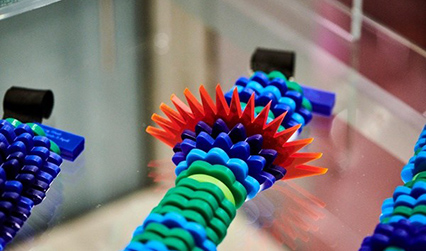‘Touching Air’ by Stefanie Posavec and Miriam Quick (2015).
Each necklace represents a week’s worth of data, with each segment the averaged data for 6 hours. The size and colour of the segments indicates the PM10 levels – small, smooth and green means good air quality, whilst large, spiky and dark blue or red means high particulate levels and very poor air quality. Can you spot Bonfire night?
Although striking, the necklaces are not delicate. They weigh heavily on the chest, just as the burden of air pollution weighs heavily on us all. Does seeing data represented this way make you think differently about the invisible dangers of air pollution?
Sarah McLusky, Life of Breath Project Manager
On Thursday 2 May data journalist Miriam Quick is talking about the creative processes behind the two artworks displayed in Catch Your Breath at our Museum Late. Miriam’s talk is at 6.45pm, with other drop-in activities throughout the evening until 8pm. Free entrance. Book online for the evening, or pop-in on the day.
The exhibition Catch your breath is open free of charge 9am–5pm, Monday–Friday until 20 September 2019.


